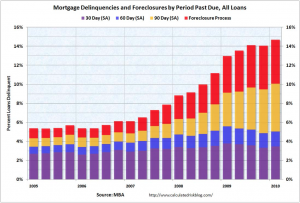The Real Story…
News and commentary about the real estate market and related topics.
Dave Parrish, ABR®, CSP, GRI, ePRO®,REALTOR ®, RE/MAX MarketPlace
The opinions expressed here are my own and don’t necessarily represent those of RE/MAX International.
Looking forward to 2011…
With only hours left until 2010 is history, there is the desire to look forward to what the future will hold, at least for 2011, if not beyond. Will it be a better year? Will it be more of the same? Is relief of our current economic stress just around the corner? We long for affirmative news… But if we can’t have that at least something on which we can base decisions, as we go forward.
While it’s still too early to have all the statistically accurate data to measure the movement of the market for all of 2010, there is certainly more than anecdotal facts to weigh the general trends and market forces likely to impact 2011.
Market will remain a buyers market… This should be no surprise. Actually, a Seller’s market is the exception and highly unlikely to re-occur for the foreseeable future.
Mortgage Delinquencies remain on the rise… Despite the words of the economists who declare the recession over, economic pressures remain real and persistent… Job growth not GDP will signal real recovery.
Mortgage Modification Programs have not produced the desired results and have had almost no impact n the market. Expect some changes in these programs during the course of 2011… if nothing else, something to streamline and standardize the process.
Foreclosures to continue… The Robo-Signing Freeze/Slow-Down will be fully raised in January… expect a measurable increase in foreclosure inventory hitting the market during the first quarter creating additional downward pricing pressures.
Short Sales to increase… Short sales have become common, as those that have to sell are faced with the reality of declining values and the inability to make-up that difference between actual market price/value and the mortgage balance.
Strategic Walk-A-Ways expected to increase… The practice of walking away from a mortgage when the mortgagor has the ability to make payments. About 19 percent of all mortgage defaults during 2009 involved strategic walk aways. The number for 2010 is expected to be higher, in the range of 25%. This horrific rejection of accountability and responsibility is likely to be addressed in some way to at least identify and categorize those who have chosen this path in a manner that will impact future creditworthiness.
Appraisal Issues… New standards in effect since mid 2009, have added to downward pricing pressure even in good markets… It is almost impossible for price levels to increase in any meaningful way under current practices. Expect lobbies such as the NAR to push for some rule changes… But there will be resistance to loosening of rules, as tightening of appraisal standards and independence is seen as the frontline of negating future abuses in mortgage lending.
Continued Price Declines… Price declines have moderated since the dark days of 2009… but they do continue albeit at a more modest rate. With more homes for sale than we have buyers it is unrealistic to believe that price declines are about to end anytime soon. Price declines for 2011 will probably be in the 2-4% range for most markets.
Interest Rates likely to increase… Interest rates have increased during the past 60 days from their historic lows. This could result in a number of buyers deciding that now is the may be the time to buy before they rise further… Note that a 1% rise in interest rates from current levels would represent a 20% reduction of buying power. While it is possible that the government may act to further restrain interest rate growth, the feeling by many is that those measures may be less effective than they have been in the past.
Summary… Overall the trends appear to point to something similar to 2010 without the peaks and valleys of 2010 caused by the Home Buyer’s Tax Credit program. We remain in the market valley and probably will remain there for a while longer. No real improvement will come without job growth that leads to real market confidence not the fleeting euphoria of Wall Street.
Finally, realize that these observations are general trends. Specific market conditions in individual micro-markets vary widely: some with a brighter picture, many with a more dismal picture. For a better understanding of the specific market conditions in your micro-market get with a trusted and qualified real estate professional. Generally, the most important questions you’ll want answers to include the following:
Current Inventory Levels
Absorption Rate (based on last six moths of sales)
Months of Inventory
Average/Median Discount from Last List Price
Price Trends
Short, Mid and Long-term outlooks for the subject micro-market.
Armed with this information you will be much better equipped to make the decisions on the course of action that makes the most sense for your specific situation.
May the market be with you.
___________


















